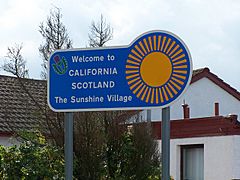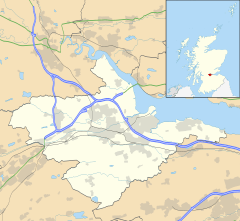California, Falkirk facts for kids
Quick facts for kids California
|
|
|---|---|
 Sign entering California |
|
| Population | 780 (2020) |
| OS grid reference | NS905763 |
| Civil parish |
|
| Council area | |
| Lieutenancy area |
|
| Country | Scotland |
| Sovereign state | United Kingdom |
| Post town | FALKIRK |
| Postcode district | FK1 |
| Dialling code | 01324 |
| Police | Central Scotland |
| Fire | Central Scotland |
| Ambulance | Scottish |
| EU Parliament | Scotland |
| UK Parliament |
|
| Scottish Parliament |
|
California (which is Calafòrnia in Scottish Gaelic) is a small village in Scotland. It's located in the Falkirk council area, between the villages of Shieldhill and Avonbridge.
This village used to be a place where many people worked in coal mines. In 2001, about 702 people lived here.
Contents
Why is it called California?
The name California for this Scottish village might make you think of the sunny state in the USA! It's believed that the name came about around the same time as the famous California Gold Rush in America (1848–1855).
People in Scotland were finding "black gold" (which is coal) in the area. So, it's thought that the village was named after the exciting gold rush happening across the world. Some old records from 1911 even say that the village was built in 1849 and got its name from the gold boom.
A Look Back in Time
How the Village Grew
California started as a place where cattle grazed. But in the 1800s, everything changed because of coal mining. Many miners began to settle there. The village was perfectly located near several coal mines, like Blackbraes and Gardrum.
By 1860, a part of the village called 'California Row' already existed. Big companies, like James Nimmo & Company, owned the mines nearby. As more mines opened, more people moved to California looking for work.
Railways and Mining Life
To move the coal, railways were built right through California. These lines helped transport coal from the mines to bigger railway networks. This meant coal from California could reach cities like Edinburgh and Glasgow.
Life for miners and their families in the early 1900s was tough. A report in 1918 showed that houses in California often didn't have washhouses or proper toilets. The village's ash-pits were cleaned only once a month.
However, things slowly got better. In the 1930s, new houses were built for the families. Even with improvements, mining was still a dangerous job. Sadly, some people from California, like Andrew Anderson and his son William, lost their lives in a mining accident in 1923.
Besides coal, some people also worked at a peat extraction site nearby. Peat is a type of soil made from decayed plants, often used as fuel or in gardening.
California Today
Today, California is mostly a place where people live. It has California Primary School, which was built in 1914 for the children of miners. There's also a local newsagent.
Recently, the local council has tried to give California a new nickname: 'The Sunshine Village'. You can even see a sign in the village that says this!
Sports and Fun
Sports have always been important in California, especially Quoits (a game where players throw rings at a target) and football.
In the 1920s, a football team called California Celtic FC was very successful. After some money problems, they even changed their name to California Rangers! Later, another team was set up in 1961.
Today, California is represented in local football leagues by two teams: California Star FC and California FC.
See also
 In Spanish: California (Falkirk) para niños
In Spanish: California (Falkirk) para niños


